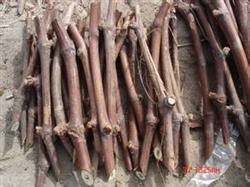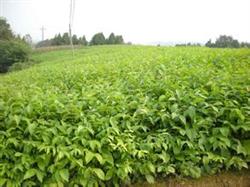Seedling cultivation by cutting of grape branches and vines

Cutting is the direct use of grape branches and vines to cultivate seedlings. According to the different types of branches, cuttage can be divided into hardwood cuttage and green wood cuttage. (1) the principle of cutting rooting, the nodes or nodes of grape branches can take root, this kind of root is called adventitious root. The adventitious root on the grape vine is formed by the division of the axile sheath cells at the junction of the pith ray and the cortex of the vine, not from the callus, so in the practice of cutting seedlings, it is often seen that healing tissue grows at the base of the cuttings, but at the internodes or nodes, although the healing tissue is not directly related to the production of adventitious roots. However, the formation of healing group plays an important role in preventing bacteria from invading, protecting scissors from decay and nutrients, and creates conditions for hair roots. There are more roots on the nodes of grape branches, at this time, because there are more nutrients stored in the diaphragm of the nodes, but the rooting of the nodes without diaphragms is relatively poor. In terms of branch age, the rooting of annual branches and twigs is better, while that of perennial vine is poor. The internodes of grape vines cannot produce adventitious buds, so the cuttings must have a full bud. The roots of grapes cannot produce adventitious buds, so grapes cannot be rooted. Grape branches and vines produce new shoots at the top of their form and new roots at the lower end of their form. This phenomenon is called "polarity". Special attention should be paid not to reverse cutting when cutting. Different kinds of grape have different ability to regenerate adventitious roots. European grape and American grape are easier to root than mountain grape and round leaf grape. it is difficult for different varieties of the same species to take root, such as Jufeng varieties. Rattan twist is a variety that is more difficult to root by cuttage. The amount of nutrients stored in grape vines is closely related to rooting. Among the nutrients, carbohydrates play an important role in the hairy root (the experiment shows that the hairy root is good when the starch content in the grape cuttings is high). Secondly, nitrogen compounds are also essential nutrients for the hairy root. An appropriate amount of nitrogen nutrition is conducive to cuttings rooting, so fully mature and robust branches are the first conditions for good rooting. (2) the collection of cuttings and storage cuttings should be collected on fine plants (mother trees) that have borne fruit and have pure variety characteristics. Cuttings should not be collected on some young trees with poor performance, serious damage to diseases and insect pests and unfruitful young trees, so as to prevent the quality of seedlings from deteriorating and variety degradation. The collection of cuttings is generally carried out at the same time in combination with winter pruning. Annual branches with full development, good maturity, short internodes, normal color, full bud eyes and no disease and insect pests are selected as cuttings and cut into 8-node branches (about 50 cm), which are tied into a bundle every 50 Mel 100, and the variety name and collection place are marked and stored in sand storage ditch. The storage ditch is located in the high and dry shade. The depth of the ditch is 60ml 80cm. The length and width of the ditch depend on the number of storage branches. Before storage, spread a layer of wet sand at the bottom of the ditch with a thickness of 10m / 15cm. Cuttings can be placed horizontally or upright, but a layer of sand should be removed from one layer of branches to reduce the breathing heat of the branches. Soil can be used if there is no sand. The soil is about 10% wet, and the bundles are filled with fine soil. The number of layers of cuttings should be 3, which is not convenient for inspection and management when there are too many, and it is easy to cause fever and mildew. The bales are erected every 2 meters or so in the middle of the strip to facilitate ventilation. After the branch g is good, the top can be covered with a layer of straw, and finally covered with 20ml 30cm thick soil, and the thickness of the covered soil should be increased appropriately in the cold areas of Northeast and North China. The cuttings should be checked frequently during the storage period to keep the temperature in the trench at about 1 ℃, which should not be higher than 5 ℃ or lower than-3 ℃. When the temperature is too high, the respiration of the branch is enhanced, the consumption and nutrition is increased, and it is easy to get mildew; if the temperature is too low, the bud eye is easy to suffer frost damage. The humidity in the storage ditch is also appropriate. if it is found that the humidity is too high and the branches are moldy, it should be turned and ventilated in time and re-stored.
- Prev

How to breed walnut seedlings in spring?
First, seed selection: select the fully mature seeds in the excellent varieties, so that the germination rate is high. That is, during the walnut harvest, most of the involucre (green skin) cracked and fell off on its own, or the involucre did not crack and fall off after about half a month of maturity. Second, seed treatment: at the beginning of March, the seeds to be bred will be sandy.
- Next

Key points of kiwifruit management in early spring
Early prevention of diseases and insect pests before germination and germination stage, 100-150 times of barium sulfide for tree insect control or 3 to 5 degrees of stone-sulfur mixture to kill eggs and overwintering bacteria. The early application of budding fertilizer was 1.5 kg per tree for big trees and 0.5 jin for young trees. Set up the pillar early and tie it up as soon as possible.
Related
- Moge, come on! The staff of the peasant association in the producing area of cantaloupe were frightened when the crowd gathered.
- Causes and Solutions of low Fruit setting rate of Apple
- Symptoms and control measures of passion fruit virus disease
- Fruit growing lesson: how do apple orchards keep high yields?
- Can you build orchards in the mountains? What are the pros and cons?
- How to manage the coloring period of Crisson grape?
- This paper introduces the processing technology of two kinds of fig products.
- How much is a month for retired teachers in rural areas by 2020?
- How can strawberry planting increase sugar content? We should pay attention to management in many aspects.
- What are the cultivation techniques on how to improve the yield of golden fruit?

